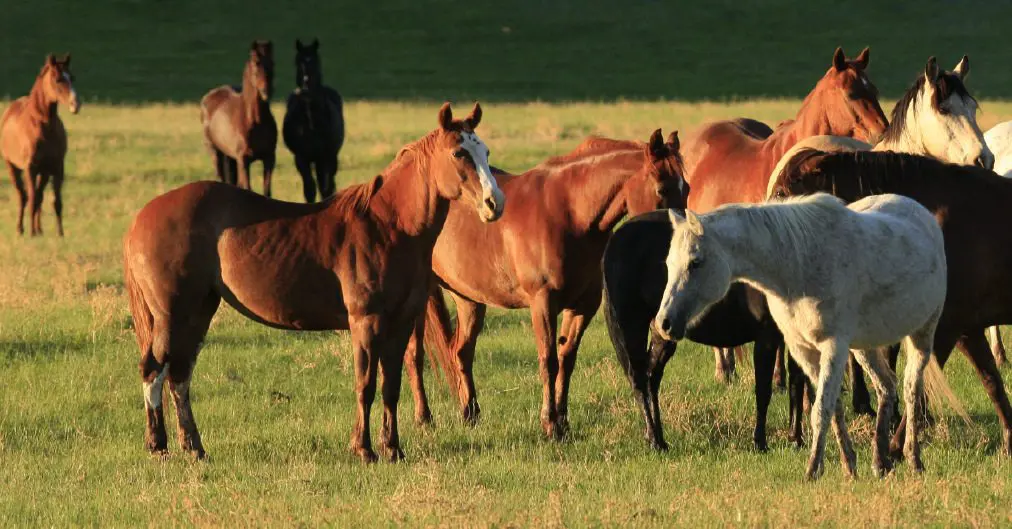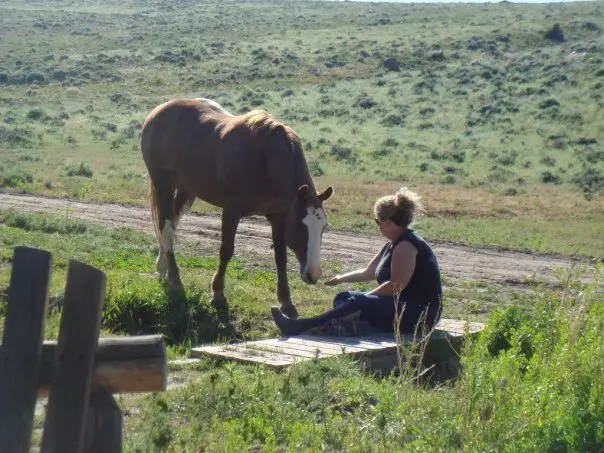Of 3 Dot and Friends…
The story of wild horses in North America is full of pathos and they have captured the imagination and sympathy of many Americans, most of whom know little about the realities of the situation. Somehow the wild horse conveys an aura of untamed beauty in nature which appeals to the starved spirits of those who live in cities and are beset by traffic jams, demanding desk jobs and the constricting mores of our society. Of course the wild horse herds of America today are a comparatively recent arrival since they are all descendants of horses brought to our shores in post Columbian times, mainly by the Spanish. It seems that horses did originally come from North America, but they have been extinct here for several millennia at least. Some scholars speculate that horses were hunted to extermination by Native Americans, like the mastodon and the giant buffalo, after their migration across the Bering Straits from Asia.

If this is true, it is ironic indeed because the wild horses made the same crossing as the Indians only in the opposite direction and, fortunately for us, they thrived and multiplied in Asia and Europe. The Spanish invaders would certainly have had a far more difficult time in conquering the Aztecs and the Incas without the huge military advantage their mounted cavalry gave them. One questions whether the Europeans would have had the economic strength to invade the Americas at all without the huge advantage horse power gave them in the development of their civilization as Jared Diamond points out so effectively in his insightful book, “Guns, Germs and Steel”.
The Spanish invaders fully appreciated the advantage horses gave them and long attempted to keep them out of the hands of Indians. Apparently they were quite successful at first, but gradually, as the number of horses vastly increased, some escaped to the wild and others fell into the hands of warlike tribes like the Apache and the Comanche. Certainly the Santa Fe rebellion in 1680 of the Pueblo Indians which overthrew Spanish rule gave a huge impetus to the spread of horses since something like a thousand of them either escaped or fell into Indian hands at that time. This is well described in Alan Taylor’s excellent book, “The American Colonies”.
The horse was well adapted to the vast grasslands stretching from deep into Mexico to the plains of Saskatchewan and Alberta. Powerful, swift and alert with excellent hearing, good eyesight and a keen sense of smell, the wild mustang is ideally adapted to this new environment. Mountain lions, wolves and bears managed to catch them now and then, but they were not able to kill a large percentage. Horses are dangerous opponents for predators and can be fierce in battle, capable of giving lethal kicks and using their teeth and powerful jaws to good effect as well. There are many accounts of horses and mules hunting down and killing wolves and mountain lions.
Wild mustangs had over a million square miles of ideal habitat available and they multiplied quickly in numbers during the 18th century. Man was their most important enemy and both Native Americans and Europeans killed them for meat as well as to use them for riding or drawing. Many feel that horse meat is one of the most succulent and nutritious of meats and is still consumed in considerable quantities in France, Poland, Iceland and several other countries. Later ranchers killed horses to keep them from consuming range land which they wanted to reserve for their domestic livestock.
Though most Indian tribes did eat horses and sometimes hunted them for meat, the acquisition of the horse for riding and transport revolutionized the existence of the Plains Indians tribes like the Sioux and the Comanche. The speed and power of a horse enabled them to hunt buffalo far more effectively and to move camp much more rapidly following the migrating herds. It was a sudden technological advance almost without earlier precedent in the history of mankind. Before the middle of the 18th century the horse had spread to the tribes far into Canada. They were acquired either by trade or by capturing wild horses which had become so numerous. The Indians adapted Spanish equestrian techniques to their special conditions and became superb horsemen. Obviously mounted Indian cavalry also became a far more effective military force than they were as foot soldiers. The Spaniards had no stomach for battle with the mounted Comanche warriors; nor did the French who tried to move into their territory from Louisiana. The Comanche dominated a region the size of France and held up Texan colonization for decades thanks to their extraordinary equestrian skills.
Certainly wild horses galloping free close together with their manes and tails flowing are a magnificent sight. J. Frank Dobie, who has written the most eloquent and authoritative book on the subject, feels that the unusual beauty of these animals is partly due to a strong element of Arab blood which was common in Spain after the Moorish invasion which lasted 8 centuries before they were finally driven out. Probably the Arabians have been bred more selectively for their endurance, intelligence, loyalty, performance and beauty than any other breed known to man. Indisputably Arabian blood is important in popular breeds like the Thoroughbred and Quarter Horse and no doubt they are partly responsible for the aspect of our wild horses today. Of course some wild horse herds have a much larger percentage of original mustang blood than others.
Whether our wild mustangs today should be considered truly wild or feral animals is a matter of controversy. Certainly their ancestors went through a period of domestication, but farther back their more distant ancestors were wild and free in North America. In early times there never were wild horses in Australia so the same cannot be said of the Australian wild horse or “brumby”, so eloquently celebrated by Banjo Patterson in his epic poem, “The Man from Snowy River”.
It was not only the Indians who profited from the abundant herds of wild horses. Mountain men and American ranchers used them extensively and much of the blood in horses still used on ranches in the West today for working cattle comes from that same pool which originated in those brought from Spain centuries ago. Many of their ancestors had been painstakingly refined by Arab nomads over millennia and these horses greatly facilitated the development of the West. They were comparatively easy to get and reasonably priced. These were the horses used by the fabled Pony Express which covered two thousand miles in seven days by horse to connect the East with the West before the telegraph. One can surely argue that the high point of the horse coincided with and was interwoven with the high point of free enterprise in America. Railways, telegraph and barbed wire fences were taking over and reducing the importance of the horse at the same time that it restricted the opportunities of men to move freely. The disappearance of that era is poignantly expressed in Cole Porter’s haunting song, “Don’t fence me in”.
In 1971, the United States Congress recognized Mustangs as “living symbols of the historic and pioneer spirit of the West, which continue to contribute to the diversity of life forms within the Nation and enrich the lives of the American people.” Those of us who love horses and riding are gratified by this richly deserved tribute. Wild horses have not quite followed the tragedy of the American bison, the greatest slaughter of wild animals known to man, and some prime areas have been set aside for their benefit.
Those of us who want to see the preservation of wild horses and, as far as that goes, the preservation of wild things in general must face the fact that since the end of the 19th century when the West was pretty well “fenced in” the world population has quadrupled and the pressure on available resources including wild land has become enormous. It is bound to grow in the immediate future. Only so many horses can live on the available land and they must somehow be thinned from time to time or, without predators, they will ruin the habitat for everything. In the long run, it is more heartless to simply let them proliferate than to find a means to thin their numbers no matter how unpalatable. More is not better. The best solution would have been to avoid the unsustainable size of our human population which is destroying our atmosphere and consuming a thousand years of fossil fuel accumulation every few days, but this discussion does not seem to be politically correct.
We have a few wild mustangs at the Bitterroot Ranch which perform very well though it takes a long time to train them. Most notable among them is 3 Dot who came straight to us from the wild. When less that a year old she voluntarily joined our horse herd when it was ranging free on a large pasture. She was part of a wild horse herd on the adjoining Indian Reservation most of which, including her mother, had been rounded up and captured. Though she stayed with our herd she would not let a person come close to her and it took long and painstaking efforts to tame and train her. You can read the touching story of this wild horse on our dude ranch website. Who is to say whether or not she is happier with us than she would have been running free with her wild companions? In any case the latter is no longer an option.
By Bayard Fox


